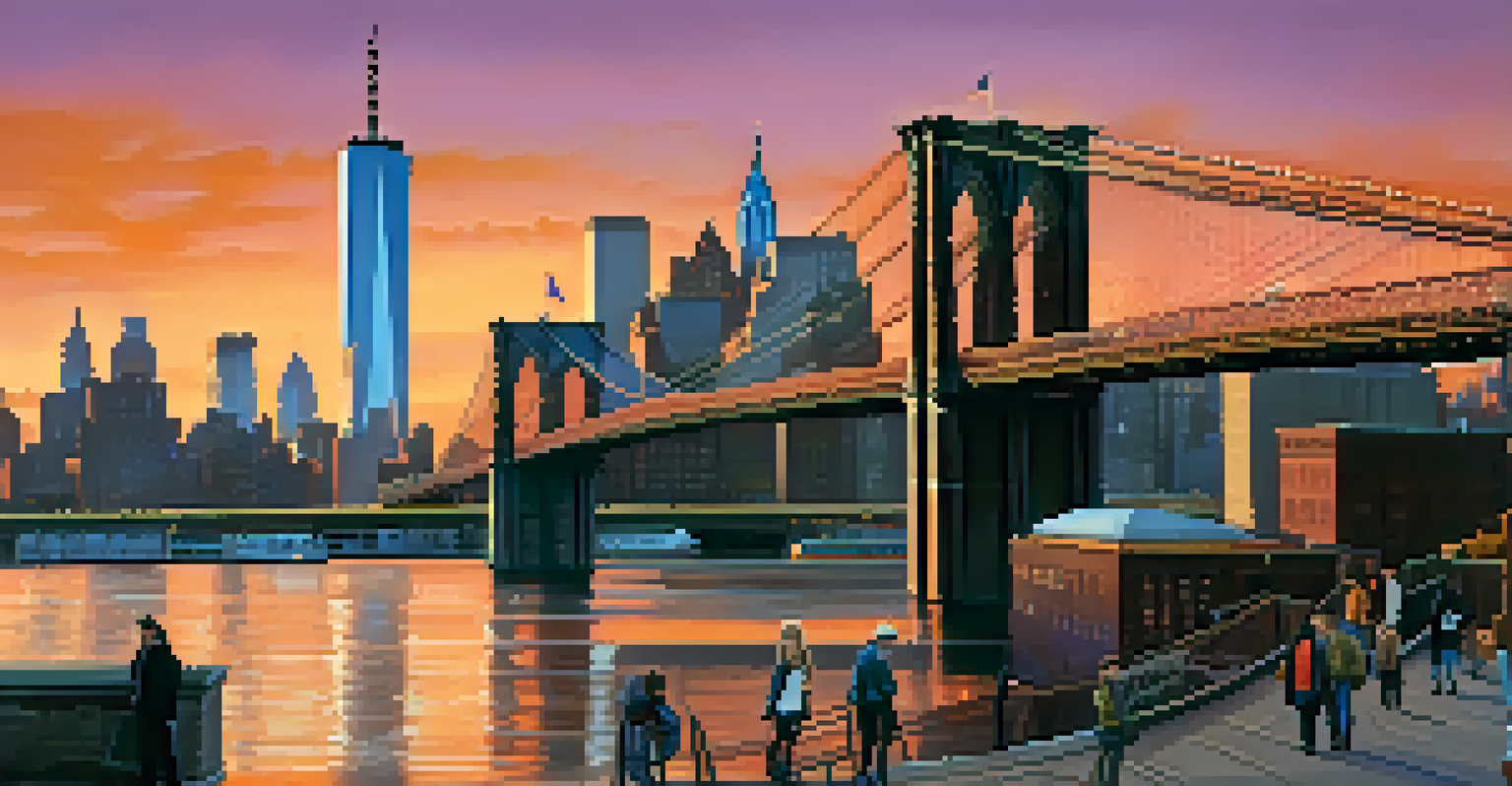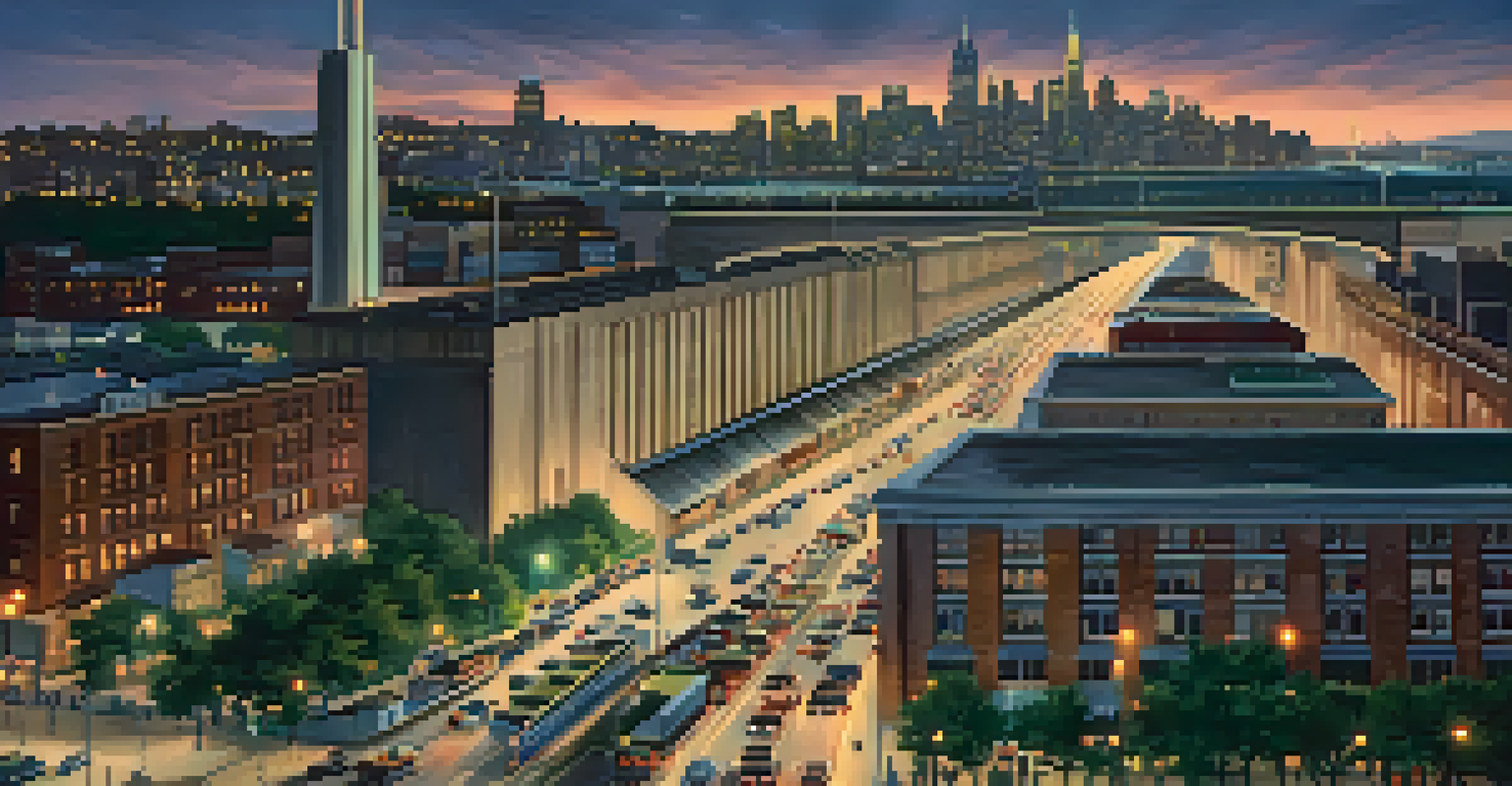Bridging Neighborhoods: NYC's Public Bridges and Tunnels

The Importance of NYC's Bridges and Tunnels
New York City is famous for its iconic skyline, but it's the bridges and tunnels that truly connect its vibrant neighborhoods. These structures are more than just pathways; they serve as lifelines for millions of residents, commuters, and tourists alike. By facilitating movement across the city and beyond, they play a crucial role in the daily lives of New Yorkers.
A bridge is a symbol of hope, bringing people together over differences.
Each bridge and tunnel tells a story of engineering marvel and urban planning. From the majestic Brooklyn Bridge to the vital Queens-Midtown Tunnel, these infrastructures symbolize the spirit of connectivity. They not only link different boroughs but also bring together diverse cultures and communities, making the city a mosaic of experiences.
Understanding the significance of these connections helps us appreciate the complexities of urban life. As we explore these structures, we learn how they shape our city and its people, fostering a sense of unity and shared identity amidst the hustle and bustle.
A Brief History of NYC's Bridges
The history of New York City's bridges dates back to the early 19th century, with the construction of the iconic Brooklyn Bridge, completed in 1883. This architectural wonder was a groundbreaking project that symbolized innovation and ambition. It not only connected Manhattan and Brooklyn but also ushered in an era of urban expansion and economic growth.

Since then, New York has seen the rise of numerous other bridges, each with its unique story and significance. The Queensboro Bridge and the Williamsburg Bridge, for instance, were instrumental in accommodating the city's growing population and industrial needs. These structures reflect the evolution of engineering techniques and the changing landscape of New York over the decades.
Bridges Connect NYC's Communities
NYC's bridges and tunnels are vital infrastructures that link neighborhoods, fostering a sense of unity and cultural diversity.
Today, these bridges stand as testaments to the city's resilience and adaptability. They have been continuously maintained and upgraded, ensuring that they remain safe and functional for future generations, while also preserving their historical charm.
Exploring Iconic Bridges: Brooklyn and Manhattan
The Brooklyn Bridge is perhaps the most recognizable symbol of New York City. Spanning the East River, it offers stunning views of the skyline and serves as a pedestrian and vehicle thoroughfare. Walking across it is a rite of passage for many, providing a unique perspective of the city's grandeur and hustle.
Tunnels are the veins of the city, allowing life to flow beneath the surface.
On the other hand, the Manhattan Bridge, often overshadowed by its famous neighbor, boasts its own charm and significance. Completed in 1909, it serves as a vital transit route for both vehicles and subway trains. Its distinct Art Deco design and stunning views of the Manhattan skyline make it a favorite among photographers and locals alike.
Both bridges not only enhance the city’s transportation network but also act as cultural landmarks. They have inspired countless works of art, literature, and music, playing a crucial role in the narrative of New York City.
The Role of Tunnels in NYC's Connectivity
While bridges are often celebrated, tunnels play an equally important role in connecting New York's neighborhoods. The Holland Tunnel and the Lincoln Tunnel, for example, provide essential links between Manhattan and New Jersey. These underground pathways help alleviate surface traffic and ensure a smooth flow of vehicles across state lines.
Tunnels are also vital for public transportation, with the subway system relying on numerous tunnels to navigate the city's landscape. This underground transit network allows millions to commute efficiently, connecting them to jobs, education, and entertainment throughout the city.
Historical Significance of Structures
The bridges of New York City, like the Brooklyn Bridge, symbolize innovation and urban growth, reflecting the city’s rich history.
Moreover, tunnels contribute to the city's resilience during adverse weather conditions. By providing alternative routes, they help maintain accessibility and keep the city moving, showcasing the importance of these hidden infrastructures in our daily lives.
Architectural Wonders: Design and Engineering
The design and engineering of NYC’s bridges and tunnels are nothing short of extraordinary. Engineers and architects have pushed the boundaries of creativity and innovation to create structures that are both functional and aesthetically pleasing. For instance, the Golden Gate Bridge may be in San Francisco, but the design principles behind it influenced many of NYC's iconic bridges.
Each bridge and tunnel incorporates advanced technology and materials to withstand the test of time. From the steel cables of the George Washington Bridge to the intricate tile work of the subway tunnels, these structures reflect meticulous planning and craftsmanship. They are designed not only for durability but also to enhance the urban landscape.
Understanding the engineering behind these structures allows us to appreciate the complexities involved in urban infrastructure. As we look at the skyline, we see more than just buildings; we see a tapestry woven from the efforts of countless individuals dedicated to improving city life.
Cultural Significance of NYC's Bridges and Tunnels
Beyond their practical functions, NYC's bridges and tunnels hold immense cultural significance. They have inspired artists, musicians, and filmmakers, becoming symbols of connection and transition. For many, crossing a bridge or a tunnel is not just a journey; it’s a transformative experience that evokes emotions and memories.
These structures frequently appear in pop culture, serving as backdrops for iconic scenes and stories. From the dramatic chase scenes in movies to songs celebrating life in the city, bridges and tunnels have become integral to New York's identity. They reflect the city's energy, vibrancy, and the never-ending hustle of its inhabitants.
Future Innovations for Connectivity
As NYC evolves, its bridges and tunnels will undergo upgrades and innovations to meet modern transportation demands while preserving their legacy.
Moreover, they foster a sense of belonging among New Yorkers. The bridges and tunnels serve as reminders of the interconnectedness of the city’s diverse communities, reinforcing the idea that, despite our differences, we are all part of the same urban tapestry.
Future of NYC's Bridges and Tunnels
As New York City continues to grow and change, so too do its bridges and tunnels. The future of these infrastructures involves not just maintenance but also innovation to meet the demands of a modern metropolis. This includes integrating smart technology and sustainable practices to enhance safety and efficiency.
Plans for expansion and upgrades are already underway, aiming to accommodate the increasing population and the need for efficient transportation. This forward-thinking approach ensures that NYC’s bridges and tunnels remain relevant and functional for generations to come.

Ultimately, the future of these structures will shape how New Yorkers navigate their city. By embracing innovation while honoring their historical significance, we can ensure that these vital connections continue to serve the community effectively.